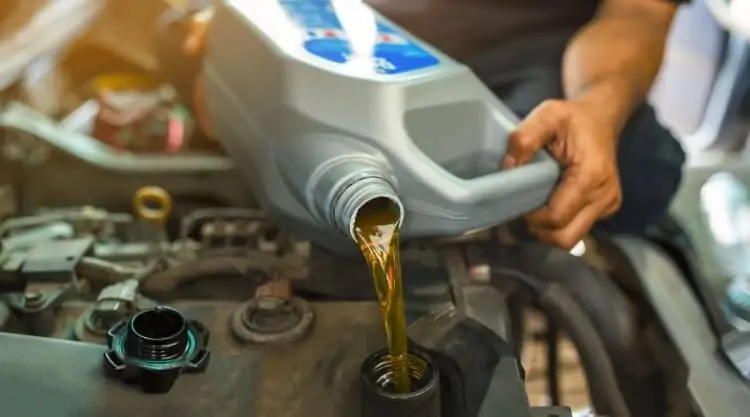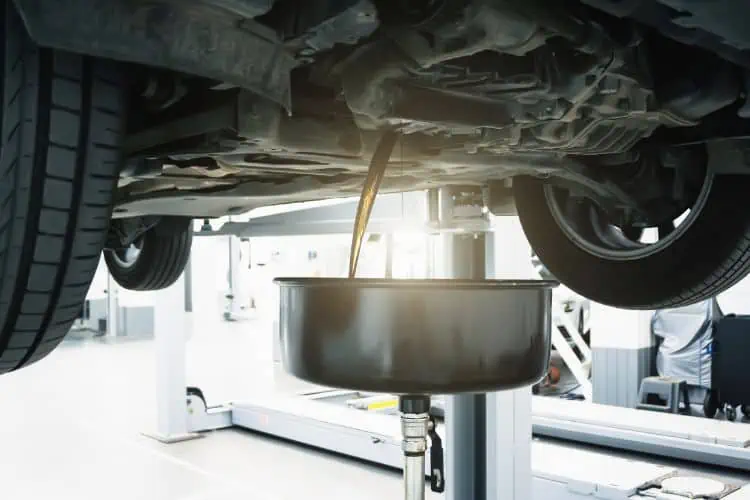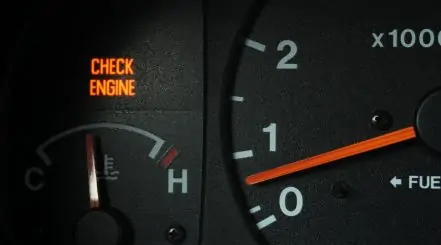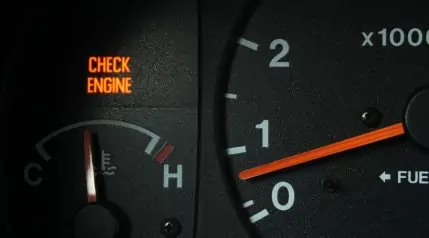
If you’re a car owner, then by now you know how important oil changes are for the health of your vehicle.
But what should you expect to pay for an oil change? The answer can range from a little to a lot, depending on your vehicle, what upsells you go for, which type of oil you need, and whether you take it to a pro or choose to take the job on yourself.
In this post, we’ll break down all the factors that can either decrease or increase the price of an oil change and provide some tips that will help ensure getting your ride serviced doesn’t cost an arm and a leg. We’ll also reveal how much an oil change costs on average at popular chains, what upsells may be offered, and whether or not these upsells are necessary.
Contents (Jump to Topic)
- 1 Key Takeaways
- 2 Oil Change Prices by Chains
- 3 How Much Does an Oil Change Cost? The Breakdown
- 4 Factors that Affect the Price of an Oil Change
- 5 Price Differences Between Synthetic and Conventional Oil
- 6 Breaking Down the Costs: What You’re Paying For When You Get Your Oil Changed
- 7 Common Oil Change Upsells
- 8 How Much Does a DIY Oil Change Cost?
- 9 Conclusion
Key Takeaways
Don’t Skimp! – Fresh oil minimizes friction between your engine’s components, thus increasing their lifespan by reducing wear and tear, and thereby making skimping on your oil change a false economy.
But Don’t Overpay, Either! – Shop around, look for coupons, and be wary of those upsells.
DIY? – Don’t attempt to perform your own oil change without the requisite tools and know-how!
The Averages – You can typically expect to pay $40-$75 for a conventional oil change and $80–$125 for a synthetic oil change.
Oil Change Prices by Chains
There’s nothing wrong with shopping around for great deals. You never know when you might find one that’s too good to miss out on, and your regular mechanic or garage never has to know.
These prices are accurate as of the date this article was published. They can vary depending on your location and any coupons you may have, and also the price of crude oil at the time of purchase.
| Chain | Oil Change Prices | What Else is Included? |
| Express Oil | $44.99-$76.99 | 20-point inspection and safety check; service completed in 10 minutes. |
| Firestone | $46-$96 | 19-point inspection and a top-off of all vital fluids. |
| Goodyear | $30.99-$95.99 | Vital fluids top-off and engine inspection (for leaks). |
| Jiffy Lube | $45.99-$89.99 | Vital fluids top-off within 3,000 miles of service; interior vacuuming; exterior window cleaning. |
| Meineke | $35-$65 | Tire pressure check; vital fluid top-off; visual brake check; tire rotation; 23-point inspection. |
| Midas | $39.99-$89.99 | Courtesy check with a written report. |
| Pep Boys | $34.99–$99.99 | Courtesy vehicle inspection. |
| Valvoline | $45.99-$95.99 | 18-point maintenance check; option to stay in the vehicle during the service. |
| Walmart | $19.88–$49.88 | Tire pressure adjustment; chassis lubrication; battery performance check. |
How Much Does an Oil Change Cost? The Breakdown
If there were universal prices for oil changes, you wouldn’t be reading this – and unfortunately, it doesn’t work like that.
You could feasibly pay as little as $20 for a basic oil change in some quick lube shops or local oil change shops. On the pricier end, prepare to shell out around $80–$125 for a synthetic oil change and $40-$75 for a conventional oil change.
Of course, there are middle-ground fees between the two, and these are more representative of a typical oil change cost.
At the end of the day, many variables influence the cost, and we’ll be going through these factors in the sections that follow.

Factors that Affect the Price of an Oil Change
Get a reasonable estimate of how hard your wallet will be hit by taking into account these factors:
- Type, and quantity, of engine oil required.
- Filter type.
- Upsells (extra services).
- Your car’s make and model.
- The business you choose and your location.
Type of Oil: The Difference Between Conventional and Synthetic Oils
Full synthetic oil? Semi-synthetic oil? Conventional oil? The type of oil you use is one of the main determinants of price.
Conventional motor oil is simpler to produce and tends to be cheaper. Unconventional versions (either synthetic oils or a synthetic blend oil) require more sophisticated production methods and so cost more.
The latter usually contain higher amounts of engine oil additives. These chemicals and compounds are added to enhance the lifespan and properties of the oil. Two common examples are anti-corrosive and detergent agents.
The manufacturing process and formula varies from brand to brand and will have a huge role in determining the cost of getting an oil change.
Plus, you have to calculate the quantity of oil your car needs, too. A four-cylinder engine will need less than 4 quarts, while larger motors (six or eight cylinders) will demand more.
Type of Filter
Filters are sold in a range of sizes to compensate for different vehicle builds. The quality of the filtration material and its construction will influence the price, too.
Required Repairs
Anything in the lubrication system that’s damaged will need replacing. This includes failing seals, gaskets, and worn pumps.
Upsells (Extra Services)
Most mechanics offer upsells – additional services the business recommends you have done at the same time.
It’s your decision how many of these extras you want to have done, though.
Know that these upsells will usually pad out your bill appreciably, so don’t let sales talk be the basis of your purchase!
Your Car’s Make and Model
Is your car rare, unusual, or heavily modified? These include antique vehicles, sports models, and high-end manufacturers such as Bentley.
Individual businesses charge you more for being unfamiliar with your make and model. These sorts of vehicles can be trickier to work on in general, and so you’ll be charged for the inconvenience.
Business You Choose and Location
You have a choice between taking your car to a chain or a local business for your oil change service. There may be competitive discounts in it for you if you have memberships to any of these chains.
Still, don’t underestimate the importance of a stable business relationship. If you’ve been going to your mechanic for years, you may already be getting a good deal.
The qualifications of the employees working on your vehicle might also increase expenses.
Last but not least, labor costs and taxes for automotive repairs can differ based on the state you’re in.

Price Differences Between Synthetic and Conventional Oil
Yes, there is a difference between the two: synthetics in all forms (whether full or blended) are more expensive, while conventional lubricants will always be a cheaper alternative.
Synthetic oil can be made using petroleum products or other materials. There’s a lot involved in the manufacturing process for this type of oil, which is why you can typically expect to pay more for a change in vehicles that require synthetic oil.
Blended oils are mixes of synthetic and conventional—the best of both worlds if synthetics are out of your price range. (Check out our dedicated article about whether or not you can mix synthetic oil with regular oil).
Breaking Down the Costs: What You’re Paying For When You Get Your Oil Changed
The total is calculated according to these criteria:
- The cost of labor.
- Oil brand and quantity.
- Filter type.
- Replacing gaskets or seals.
- Upsells.
- Sales tax.
Cost of Labor
Estimated Cost: Specific to the business.
The cost of labor is unavoidable when you go to a professional. As we explained earlier, this will largely depend on the business itself. Technicians may be paid at an hourly rate or fixed rates per job.
Oil Brand and Quantity
Estimated Cost: $30–$50 (for 5 quarts).
Synthetic oil brands are the most expensive; conventional is the least costly. Blended brands fall somewhere in the middle.
Five quarts‘ worth of conventional lubricant can be as little as $28. On the other hand, the same quantity of synthetic oil can be up to $50.
This might not be too bad if you only need 4 quarts or less. Those of you with more powerful vehicles demanding synthetic could spend well over $80 on lubricant alone, though.
Filter Type
Estimated Cost: $3–$15
Based on the brand, size, and compatibility, filters can cost anywhere from $3–$15. If you have a luxury or high-performance vehicle, this will likely cost more.
Filters play a major role in preventing contaminants from circulating your vehicle with your lubricant, so we advise prioritizing quality when choosing a new oil filter.
Worn-Out Gaskets or Seals
Estimated Cost: $5–$30 (based on the gasket or seal).
Any leaking, brittle, or cracking seals or o-rings have to be replaced.
These rubber or plastic parts are inexpensive, but their installation is expensive if it’s time-consuming and effort-intensive, such as working on the oil pan gasket.
Potential Upsells
Estimated Cost: It depends on the type and number of upsells you choose; as well as the business’ prices.
We detail the most common upsells you’ll come across below. It’s easy to forget how each one adds up when you’re talking to a professional salesperson, so be wary of this, and make sure you receive a set figure before agreeing to anything.
Sales Tax
Estimated Cost: Particular to where you live.
This will be unique to your state and county.

Common Oil Change Upsells
The practice of upselling isn’t necessarily malicious or an attempt to con you. On the contrary, your vehicle may be in genuine need of some of these services.
However, don’t believe everything the salesperson or technician tells you just because you’re hearing it from them.
Use your common sense to decide whether or not an upsell is necessary for your car at this point in time.
Expect to hear all about the virtues of paying for:
- Synthetic or blended brands.
- Tire rotation and pressure check.
- Coolant change.
- Air filter replacement (in your car’s engine, cabin or both).
- A fuel system cleaning.
- New windshield wipers.
Synthetic or Blended Brands
Do you normally use conventional oil? In that case, expect to hear all about the benefits of upgrading your lubricant to a synthetic or blended brand.
Remember that these types run more expensive. So, consider how you use your car before agreeing to this.
Lightly used, low-mileage automobiles may not reap many advantages from an upgrade.
Tire Rotation and Pressure Check
Tire rotations are generally recommended every 6,000 to 8,000 miles. This is about the same amount of time between oil changes.
Pressure checks are best performed every month to ensure inflation is optimal. You should be doing this yourself anyway.
Skip this upsell if you’ve had a rotation done elsewhere in the near past.
Coolant Change
Most brands of antifreeze on the market today are made to last for a long time.
Topping off your coolant is one thing, flushing the radiator and changing it is another.
Consult your vehicle’s owner manual to know how often you should be changing it. So-called “extended-life” coolant changes can be as infrequent as once every five years.
Air Filter Replacement (Engine, Cabin, or Both)
How often you need to change your cabin air filter depends on both time and usage, but usually last for between 12,000 to 15,000 miles based on the brand you have.
The air filter in your vehicle’s engine can last up to twice as long: 15,000 to 30,000 miles. Driving on unpaved terrain or through polluted areas will shorten this estimate, though.
If either of these filters was replaced during your last change, decline this upsell.
Fuel System Cleaning
Individuals with older vehicles (e.g., with a carburetor) may warrant this service.
On the other hand, modern cars are unlikely to require a fuel system cleaning unless troublesome symptoms have appeared.
We’re talking about obvious issues like the check engine light and sluggish engine performance. Your vehicle’s owner’s manual indicates how often this should be done.
New Windshield Wipers
Windshield wiper blades should be replaced on average once per year. Seasonal blades that are switched out every winter and summer will last for longer.
Squeaking, dragging or streaks are all signs of worn-down blades. If you haven’t noticed anything wrong, there should be no need for a change at this point in time.

How Much Does a DIY Oil Change Cost?
If you choose to change your oil by yourself, you’ll eliminate the cost of labor but will still be paying for:
- The vehicle’s oil and filter.
- Necessary tools and equipment.
Price of Oil and Filter
Estimated Cost: $3–$15 for the filter; $28–$45 for the oil.
Filters are rarely more than $15 – the type and quantity of lubricant you need impacts the price significantly.
Conventional is always the lowest-cost variety. Synthetics, blended and specialized lubricants (e.g., high-mileage oil) are more expensive.
Necessary Tools and Equipment
Estimated Cost: $10–$200 for oil filter wrench or kit; $30–$40 for a drain pan.
The tools and equipment you need for the job are one-time investments. Aside from safety gear like gloves and goggles, you need an oil filter wrench and drain pan.
A wrench can be as little as $10 and drain pans are typically $30–$40.
Conclusion
As you can probably tell by now, there isn’t a fixed answer to what you’ll find yourself paying for an oil change.
That’s because the cost of an oil change varies depending on several different factors, all of which we’ve discussed above.
Now that you know all the factors that go into the final price, you can do your own calculations based on what you want/need, and come to a close estimate.
If your primary goal is to save money, a DIY oil change is the most cost-effective option. You can’t really beat DIY! However, this might not be something you’re willing to attempt, especially if you lack the time or expertise to do this yourself. If you have no other choice but to take your car to a professional for an oil change service, take the time to check for discounts and coupons for local businesses and chains.





